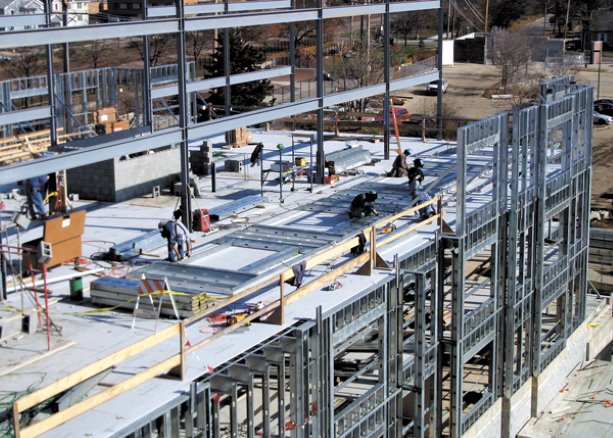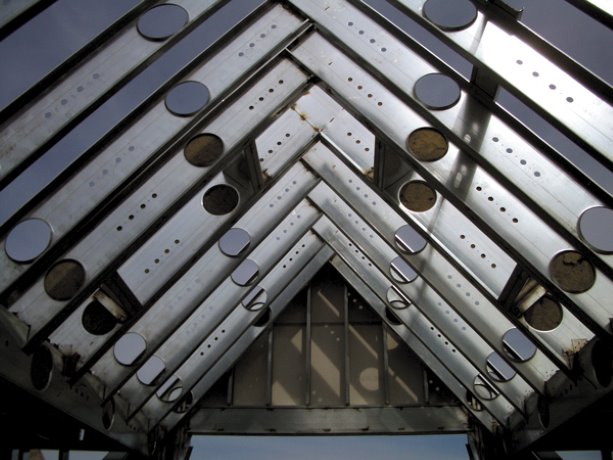Cold-formed steel (CFS) is challenging engineered lumber as the material of choice for mid-rise structures, says Larry Williams, executive director for the Steel Framing Industry Association.
In fact, he adds, CFS could even go higher if the economics align.
"We had an engineering study done which shows it is feasible to go 40 storeys with CFS, though economically it isn’t viable," he states.
To make it more viable, codes would have to be updated and other work carried out. Still, he says, it’s a promising future.
Proponents don’t see much of a future in residential single family homes but they do see potential in multi-unit, multi-storey structures beyond the three storey low-rise.
The sector took a small hit when building codes in jurisdictions across North America were changed to allow wood-framed structures for mid-rise application.
Engineered lumber surged briefly, Williams says, but things have swung back again.
It’s rebounding partly because of the economics and partly because of the alleged risks inherent with wood’s vulnerability to combustion, especially during the construction phase, he notes.
Larry Williams
Steel Framing Industry Association
The upshot, Williams says, is that insurance coverage during the construction phase is much more expensive and some carriers are demanding 24-7 live security.
"The costs of builder’s insurance with concrete (in U.S. figures) is about nine cents per $100 of value. CFS is 14 cents to 15 cents per $100 and wood is 89 cents per $100," he says. "That’s substantially adding to the cost of development. One building was costed at US$300,000 for concrete and $1.2 million for lumber. The owner went for concrete."
With the United States fully out of the recession following the 2008 financial crisis, he says construction has picked up and interest in CFS is rising.
"We’re seeing a push to four to eight storeys and pushing to nine storeys and we think it could to go 12 storeys," he says.
Paul De Berardis, RESCON’s director of building science and innovation, says CFS is generally used for low-rise commercial structures such as big box stores.
"There is one building, Bone Structure, using it for custom single family homes," he says. "The problem though is one, the cost, which is more than wood, and two, you can’t just cut it like you can with dimensional lumber to make a joist. It’s an engineered product so you have to work with those limitations."
He says he hasn’t heard of any push in Canada to build three or more storeys with CFS, unlike the U.S.
Wood, however, seems to be gaining ground for four-to six-storey projects and both the Ontario government and the industry are working to create best practices, including guidelines on how to reduce fire risk during the construction phase.
"With lumber, you have an established supply chain and trades," Williams says.
The wood sector is investing heavily to promote their technology, Williams says, and steel will continue to market their option too.
"We’re at about 30 to 35 per cent of the market for low- and mid-rise, which is good," he says.
Brock Martin, president of Magest in Ontario, which has specialized in CFS for 25 years, says even with the initial surge of interest in wood-frame mid-rises, steel has held steady or grown.
"Our market share is growing quite well," he says. "In 2005 we had to fight for every job but today mid-rises, up to seven storeys or so, is more accepted for cold-formed steel."
Magest has projects across Canada including hotels and a seniors residence.
"For those projects, of course they like the non-combustible aspect," he says.
Mike Stiller, manager of global R&D construction at ArcelorMittal Dofasco in Hamilton, Ont., says CFS framing has been quietly holding market share for years in Canada, especially on ICI projects.
"Hospitals and seniors residences, even some hotel chains, need non-combustible construction so they go for steel and concrete," he says. "Certainly, mid-rise is a sweet spot for steel. When you look at the cost over the life cycle, the fact steel is non-combustible and is wholly recycled at demolition or renovation, it’s very sustainable and cost efficient."
Steel isn’t susceptible to shrinkage or mould, he states.
While a 40-storey tower framed with CFS isn’t likely, he adds, there’s no reason why CFS shouldn’t be a viable choice for mid-rises and up.
"As one of the managers here has said, ‘steel has always had a great story to tell but the problem has been we’re lousy storytellers,’ " says Stiller. "We’re changing that."
Premiers from East and West express disappointment
OTTAWA — Premiers across the country are also reacting to news of the Energy East cancellation, with most stating it’s a huge blow to the country.
Alberta Premier Rachel Notley delivered a statement to media noting while the government understands it was driven by a broad range of factors, it is an unfortunate outcome for Canadians.
"Our government has supported Energy East since the project was proposed," she said, adding the National Energy Board needs to send a clear message on what the future of project reviews looks like in Canada as investors need confidence. "This decision highlights the importance of diversifying market access and the subsequent national priority that must be placed on the Trans Mountain expansion project."
Saskatchewan Premier Brad Wall was not as kind, calling the cancellation not a good day for Canada or the federation and a very bad day for the West.
"TransCanada made the decision to cancel Energy East — but make no mistake, the reasons for it fall at the feet of Prime Minister Justin Trudeau and the federal government," said Wall in a statement. "They have been, at best, ambivalent about the project and then moved the goalposts at the last moment by asking the regulator to consider the impact of upstream greenhouse gas emissions."
Wall added TransCanada committed more than a billion dollars to the project and made 700 changes to its plans in response to concerns.
"Make no mistake, other companies’ decisions to invest in Canada will be informed by this debacle," said Wall, also criticizing that Western provinces send $2.5 billion in equalization payments to help support Quebec despite the fact that low energy prices have resulted in job losses and lower revenues for the last four years.
"Something needs to change," Wall said. "For the West to continue on like this in our federal system is the equivalent of having Stockholm syndrome."
New Brunswick Premier Brian Gallant said in a statement to constituents that TransCanada’s decision is "not good news for those who wanted to see the Energy East pipeline built — and your provincial government falls firmly in that camp. Like many New Brunswickers, we are disappointed. The project would have created jobs in New Brunswick and helped the Canadian economy."
Federal Energy Minister Jim Carr told the media TransCanada’s decision was motivated by business considerations influenced by the state of commodity prices. He also noted the government already approved two other projects, the Trans Mountain and Line 3 expansions.
— With files from the Canadian Press












Recent Comments
comments for this post are closed